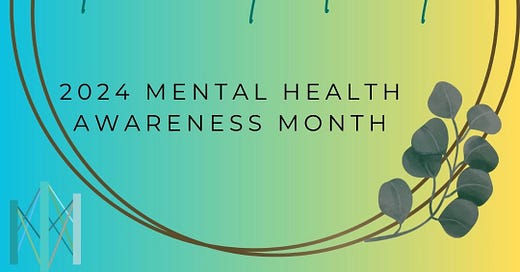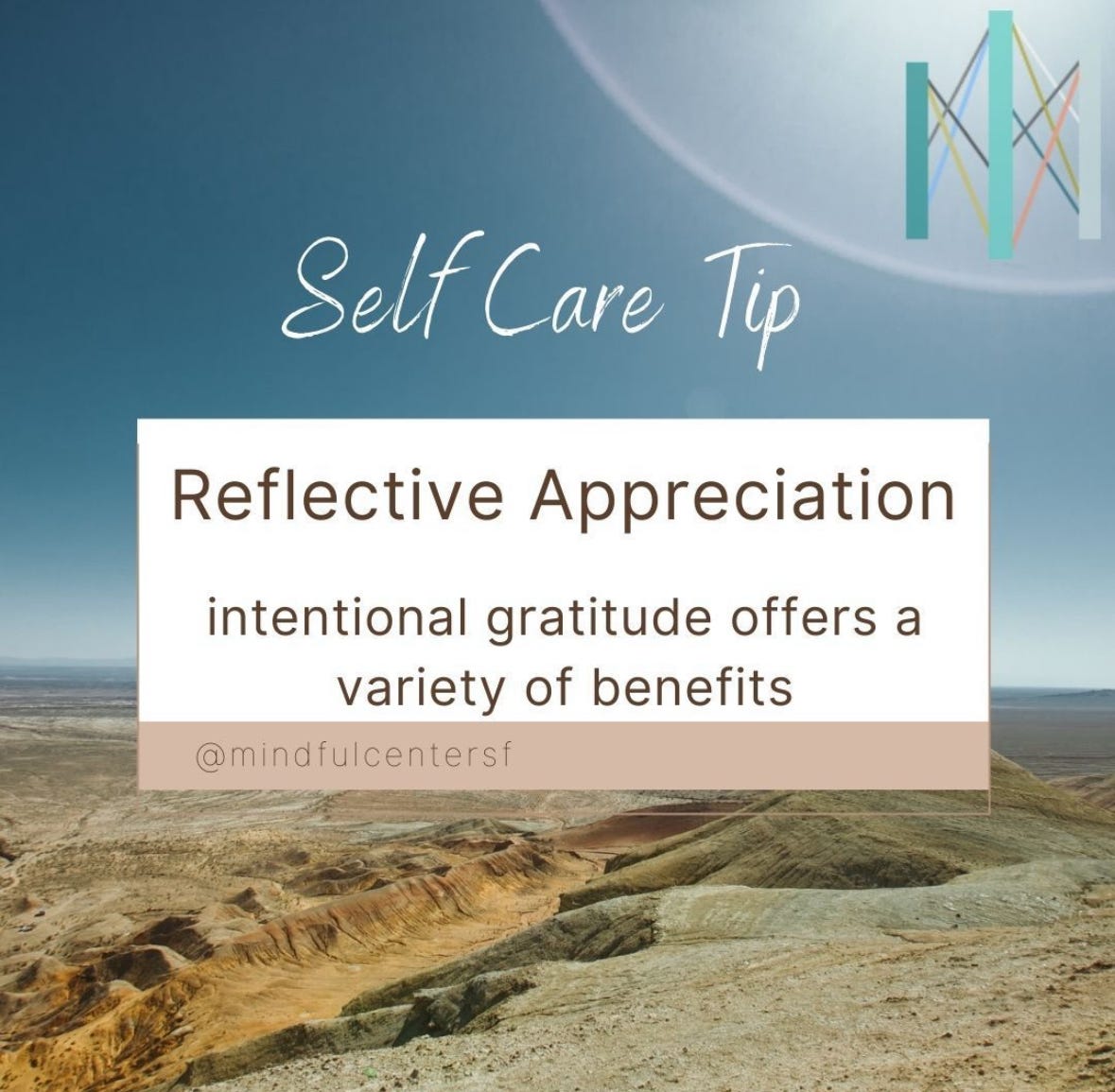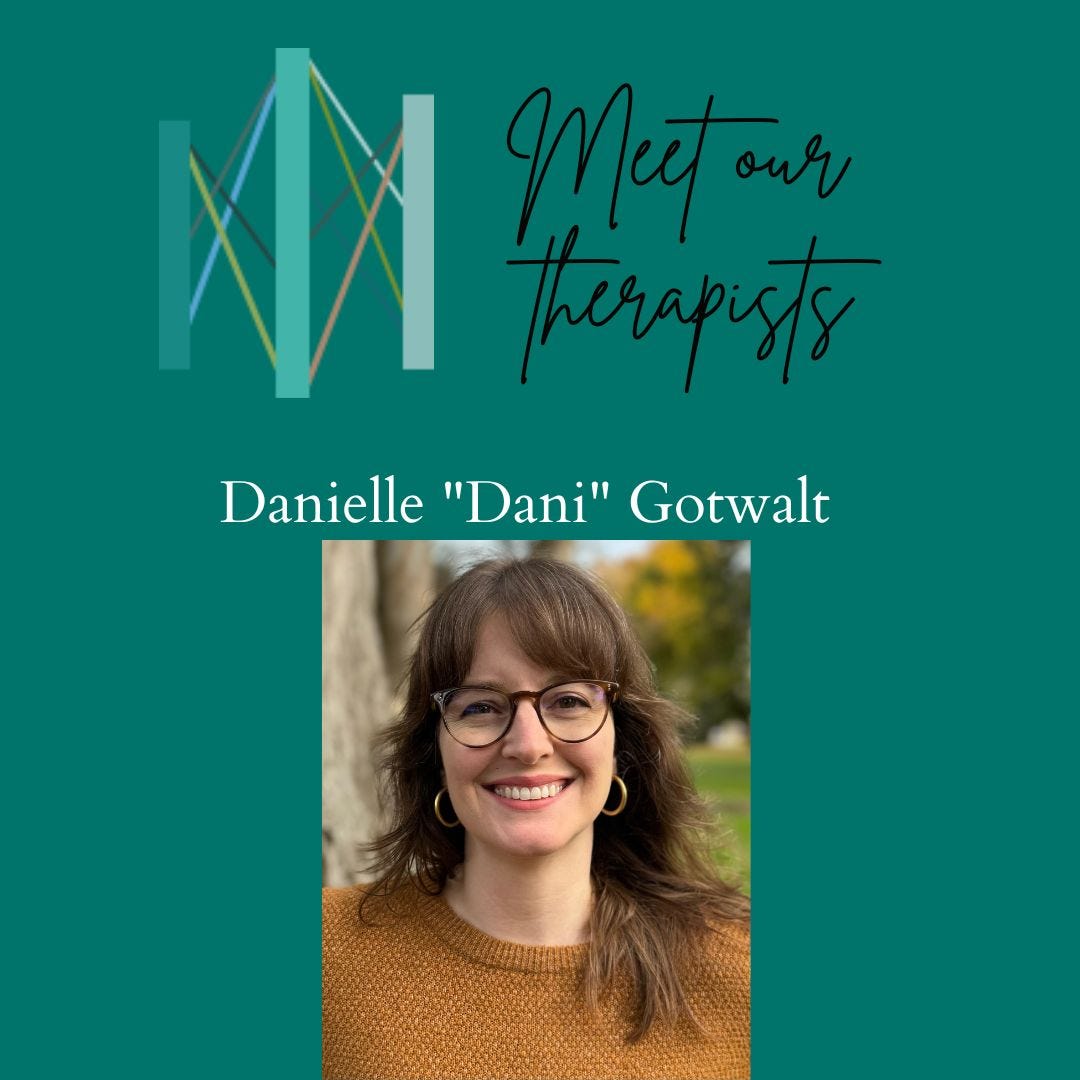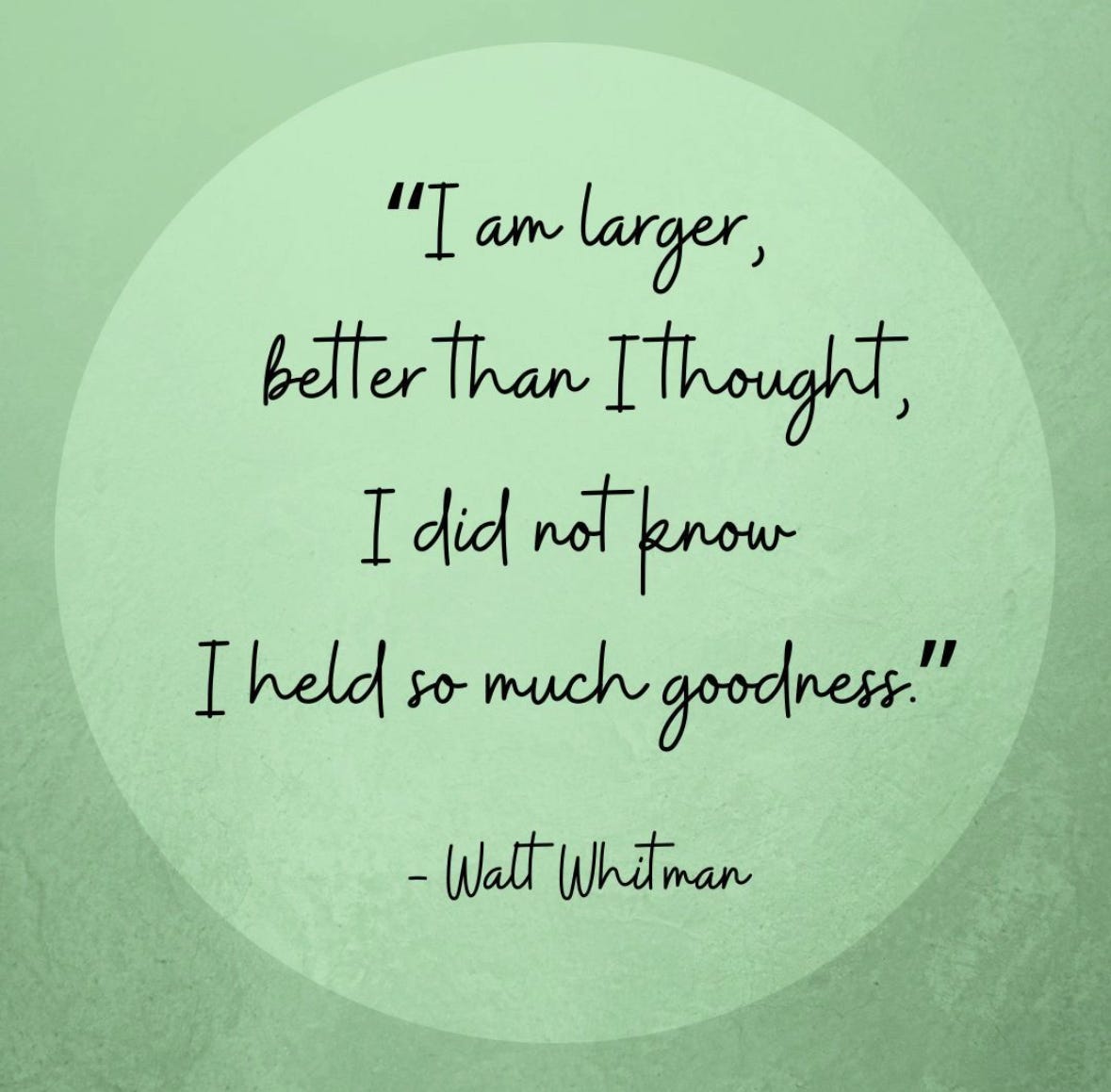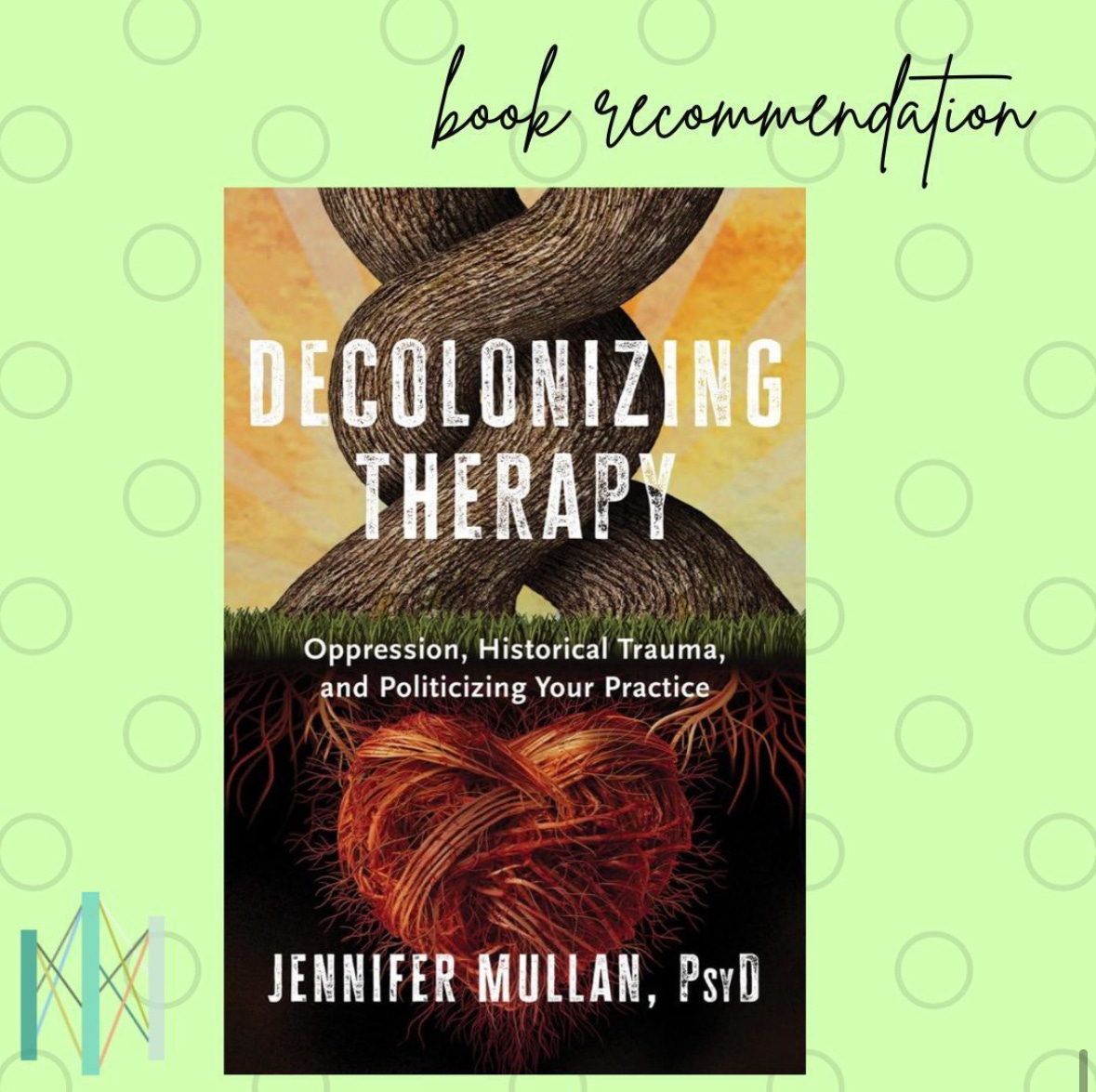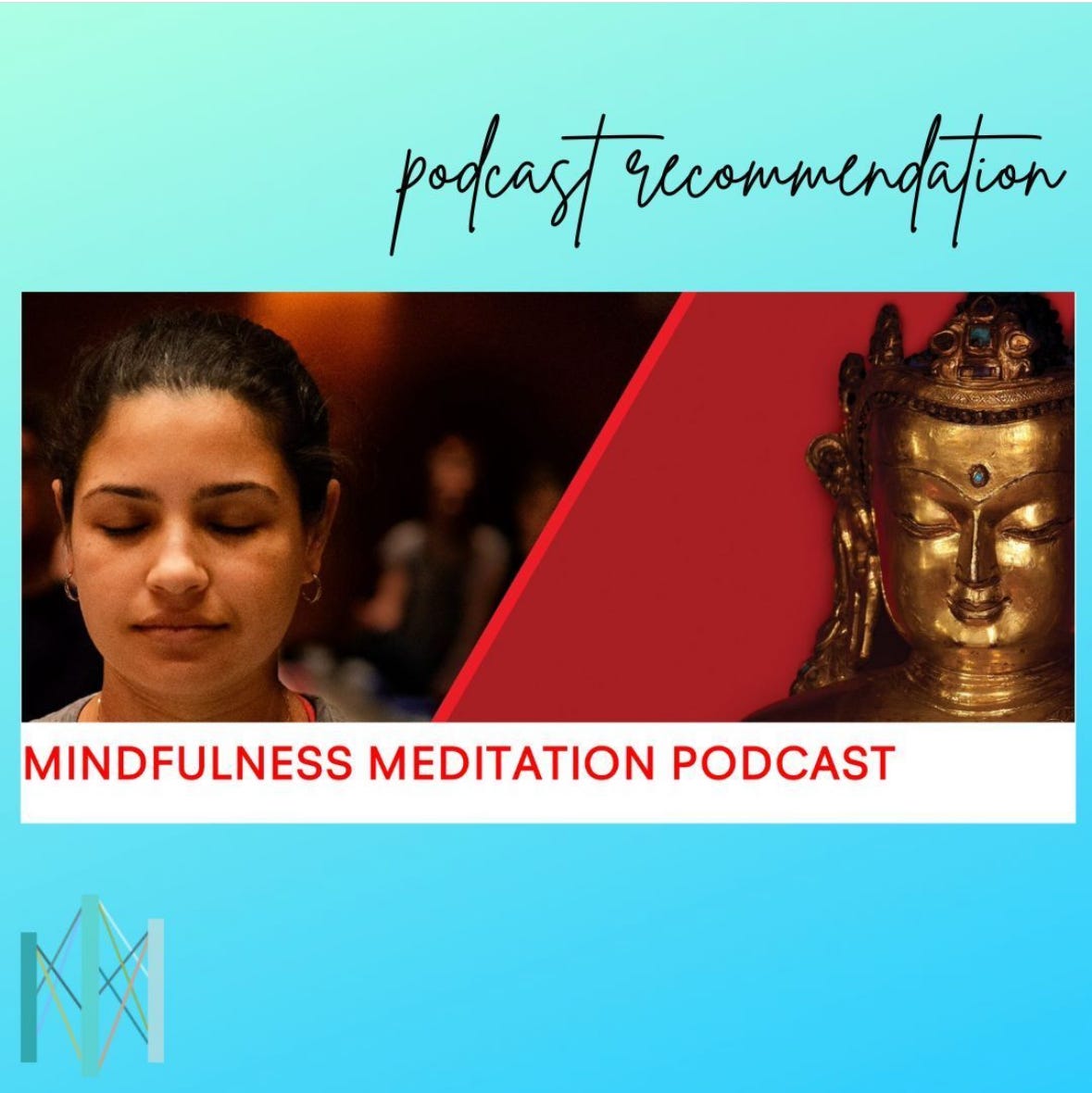Center for Mindful Psychotherapy, May Newsletter
Your monthly newsletter from our non-profit collective of over ~100 Associate Marriage and Family Therapists in the San Francisco Bay Area
Bringing You A Moment of Mindfulness
Today is the last day of Mental Health Awareness Month, but, of course, it’s important to keep talking about mental health all year long. This year’s theme was “learn, act, advocate” so we have some links today for you about each of those topics. We also have a guest post on what to say to someone who is grieving, some information about AEDP therapy, and a series of mental health tips and recommendations.
Before we dig in, though, here's a reminder to take just a moment to land here. You do not need to multi-task. You don't have to think about what's next. Be right here with these words on this page. Listen to your own heartbeat and feel your feet on the ground as you take in these ideas. We are happy to be here in this space with you.
Learn, Act, Advocate: Mental Health Month in a Changing World
May is Mental Health Awareness month. While awareness about mental health issues is obviously important all year long, this campaign brings the opportunity to really spotlight not just general mental health but also the issues that are key to the community in any given year. In 2024, Mental Health America announces the theme of Where to Start: Mental Health in a Changing World, focusing on three key actions: learn, act, advocate. Today we’ll provide an overview of these and throughout the month we will elaborate.
What is Mental Health Awareness Month?
This annual observance is dedicated to raising awareness and understanding of mental health issues, reducing stigma, and promoting access to mental health resources and support. Learn more here.
Mental Health Awareness Month 2024: Where To Start
Amidst a world in constant flux, this year’s focus for Mental Health Month underscores the challenge of navigating change while prioritizing mental wellness. It’s a reminder that as personal relationships and the demands of work and academics continue to exert their influence, external factors like politics, climate change, and economic fluctuations also play a significant role in shaping our mental state. While societal conversations around mental health are becoming increasingly prevalent, many still grapple with where to begin in tending to their own well-being amidst these multifaceted dynamics.
Where to Start: Learn
Understanding how external factors influence mental health is crucial. These factors, ranging from controllable elements like screen time to external circumstances like access to resources or global events, shape our well-being. Social determinants such as economic status, education, neighborhood, and access to resources profoundly impact mental health, alongside physical well-being. Loneliness, technology, and societal factors all contribute to mental health challenges, but protective measures and support systems exist to mitigate their effects. Despite the uncertainties and fears of the world, reaching out and seeking connection can alleviate the burden of isolation and provide hope for better mental health. In today’s digital age, managing screen time and fostering meaningful connections are vital for preserving mental well-being amidst the pervasive influence of technology.
Here’s a complete article about the “learn” aspect of Mental Health Awareness Month.
Where to Start: Act
Taking action to enhance mental health and build resilience involves a variety of strategies, both large and small, tailored to individual circumstances. Knowing when to lean on the support of friends, family, and colleagues during life’s challenges is a key step in improving mental well-being. Embracing change, even when it’s difficult, and developing coping mechanisms to navigate transitions can help prioritize mental health and foster acceptance of situations beyond our control. Recognizing that life’s difficulties shouldn’t dominate every day, individuals can utilize free, anonymous mental health screenings at mhascreening.org to assess symptoms and access resources, tips, and potential treatment options. These screening results can serve as a starting point for discussions with healthcare providers or trusted individuals, guiding the development of personalized action plans to address mental health concerns. Seeking professional assistance when self-help efforts prove insufficient demonstrates strength and resilience, offering a path to support and healing through life’s challenges.
Here’s a complete article about the “act” aspect of Mental Health Awareness Month.
Where to Start: Advocate
Advocating for mental health doesn’t always require engaging with government officials or community leaders directly. Simple actions can contribute to changing perceptions and treatment of mental health conditions. Sharing personal stories can play a crucial role in reducing stigma and fostering open dialogue. While advocating for policy change may seem daunting, individuals possess the ability to influence decision-makers by contacting elected officials and advocating for increased funding for mental health services, expanded treatment access, and protections for individuals with mental health conditions. Supporting the integration of mental health care into primary care settings and promoting mental health programs in various settings, including schools, workplaces, and communities, can benefit overall well-being. Particularly in election years, it’s essential to be informed about candidates’ stances on mental health issues and to prioritize mental health when casting votes.
Here’s a complete article about the “advocate” aspect of Mental Health Awareness Month.
Mental Health America offers additional information and resources related to this year’s campaign.
If you’re seeking guidance or support for your mental health journey, don’t hesitate to reach out to us. Together, let’s navigate the path to better mental well-being. Contact us today for more information and support.
Set aside a few moments each day to engage in a reflective appreciation practice. Find a quiet and comfortable space where you can sit or lie down comfortably. Close your eyes and take a few deep breaths to center yourself in the present moment. Reflect on the events of the day and identify three things that you're grateful for or that brought you joy. These could be simple moments of kindness, unexpected surprises, or experiences of beauty and wonder. Allow yourself to fully immerse in the memory of each moment, relishing the feelings of gratitude and appreciation that arise. As you cultivate a sense of reflective appreciation, notice how it uplifts your spirits and brings a sense of warmth and contentment to your heart.
From a therapeutic perspective, reflective appreciation practice serves as a powerful tool for promoting emotional well-being and cultivating a positive mindset. By intentionally focusing on moments of gratitude and joy, you can shift your perspective from what's lacking to what's abundant in your life. This practice not only enhances feelings of happiness and fulfillment but also strengthens resilience and fosters a sense of connection with yourself and others. Incorporating reflective appreciation into your daily routine can help you cultivate a deeper sense of gratitude and appreciation for the richness of life, even in the midst of challenges or uncertainties.
What to Say to Someone Grieving, guest post by Associate Therapist Dani Gotwalt
We always appreciate when our associate therapists take the time to speak directly to you themselves, through blog posts or videos. This month’s post was written by our Associate Therapist Dani Gotwalt. Learn more about working with her here.
Despite being a therapist who specializes in grief and has experienced my own losses, there are times when someone in my life suffers a loss and I find myself frantically trying to find the “right words” to show them support. This happened a year ago and, in a moment of uncertainty, I took my question to google. The results were terrible, predominantly clichés that I remember hating when I experienced the sudden loss of my father 16 years ago. Sayings like “They are in a better place,” “Everything happens for a reason”, or “Time heals all wounds.”
I ran a grief group a few years ago and one of our most engaging nights stemmed from a conversation about so many of those popular “grief” sayings. They may come from a good place, but can make those grieving end up feeling really empty, isolated, and dismissed. So if perhaps an uncertain Google search has brought you here, I want to offer up some alternatives of what you can say to someone grieving.
But first, a few important notes about grief:
1) No two people grieve alike. When my father died, my sister and I processed the loss in nearly opposite ways. Neither way was good or bad, it was unique to us and our relationship with him. I see this uniqueness in my clients and friends when they experience a loss. So when I approach someone grieving, I do hold my experience in the back of my mind, but I also hold A LOT of space for how their particular grief is being expressed, without assuming we will in any way look the same. There is a chance these suggestions I offer below will not resonate for the grieving person in your life. The guarantee of anything fitting every person or situation is a fallacy (albeit a comforting one).
2) You will not be able to take away their pain. There can be this idea that if we say the right thing, we will make our person’s grief diminish. I personally believe grief is an expression of love – that missing their beloved person is not something we need to fix. I hope this can take some of the pressure off of the specific anxiety of “What do I say?!?” It will also be important to practice good self care, so that you can be comfortable with the discomfort of sitting with someone’s pain.
3) It is important to acknowledge their loss. They may not want to talk about it, but there will be others in their lives who, for a variety of reasons, may not feel comfortable or able to acknowledge their loss. Loss can feel isolating and, depending on the type of loss, alienating and stigmatizing. I remember it stinging when family, friends, and community members didn’t mention my father. While I hold an understanding now that perhaps they were uncomfortable or were worried that mentioning it to me would hurt, the lack of acknowledgment felt like they were saying “we don’t want to talk about your loss.”
What to say to someone grieving:
Be specific to the griever or the person they lost. Rather than the “one size fits all” sayings for bereavement, say something personalized. For example “I know how much this person meant to you, given how you two met and the experiences you shared in high school.” This is tricky if the person grieving is someone you don’t know well but I encourage you to try, even if it’s something like “I know we don’t know each other well, but I’ll be holding you and your family in my heart.”
If you want to offer help or support, offer options. Don’t say “Let me know if there’s anything I can do for you”. If you have capacity, help them with the mental load of figuring out what they need, and then it’s really important you follow through with intention. The person might not know what they want or need at that moment, but could potentially say yes to suggested ideas, like:
“I can drive you to that appointment”
“I can bring you food tomorrow night, do you want [favorite dish] or [other favorite dish]?”
“Do you want me to come over and distract you with a [favorite show] viewing marathon?”
“I’m happy to come over and just sit next to you and we can talk about them or not.”
Offer to hear stories about their loved one. If you are close to the griever and feel comfortable, let them know you are there for any type of story they want to share: the high points and low ones. Our relationships with our loved ones can be complicated and those wounds don’t go away when they pass. For my own experience, I mostly wanted to tell funny Dad stories. It was only with time and therapy that it began to be important to talk about the painful ones. Follow the lead of the griever, and just make it an option. If you’re very close with the person and have your own stories about their loved one, check in to see if they want to hear your stories.
“Whenever you want, I’m here to hear stories about and see photos of [their loved one].”
“Do you want me to share my favorite story about [their loved one]?”
More important than the right words: Be there for them
This is a time when the old adage rings truest – your actions will speak louder than words. What you do, not what you say, matters most right now. Depending on your relationship with this person and your own capacity, this will look specific to each situation. If this is a close loved one, can you make space in your calendar and life to be extra available and flexible for them? Can you set reminders in your calendar to check in with their grief at the 6 month or year mark? Often there’s a flood of support right around the time of the loss, but it can quickly dissipate. It can feel really lonely during that first year of loss after the flood goes away, so staying in touch and checking in goes a long way.
I’ll end with a story. After my father’s funeral, my best friend drove me from my hometown back to college and came with me to my classes for a few days. She went above and beyond to be there for me. She also unintentionally said something inappropriate related to how my Dad died. When I pointed it out to her, I laughed, she was horrified, and I was ok! It did not break me. I was just so grateful to have my best friend with me and not feel alone.
As I said earlier in this post, nothing you do or say will take away the grieving person’s pain, and that’s not possible. If I could leave you with a goal as a member of the grieving person’s community, it’s to make sure they don’t feel alone as they ride the waves of grief and adjust to their life with this devastating heartbreak in it.
Dani Gotwalt is an Associate Therapist with Center for Mindful Psychotherapy. In her therapist bio, she says, in part “My style is collaborative, mindful, somatic, strength-based, compassionate, and (when appropriate) playful. You are the expert on your lived experience, and I’m here to walk alongside you as you become even more you!” Contact her about working together.
What is AEDP?
Accelerated Experiential Dynamic Psychotherapy (AEDP) is a relatively modern therapeutic approach that has evolved over the past few decades. It draws from various therapeutic traditions, including attachment theory, affective neuroscience, and body-focused approaches. As a result, AEDP is a therapeutic approach that delves into the intricacies of your emotions and their profound impact on your life.
Picture a therapeutic process where you work closely with a trained therapist to gain profound insights into your feelings, particularly the complex and challenging ones. AEDP essentially serves as a catalyst for emotional transformation. It can be especially valuable if you’re dealing with issues like unresolved trauma, anxiety, or relationship difficulties, although it works for other challenges as well.
Key features and principles of AEDP therapy include:
Emotional Processing
AEDP encourages individuals to explore and process their emotions deeply. Clients are supported in identifying and expressing their emotions, especially those that have been repressed or avoided due to past trauma or difficulties.
Transformative Processes
The primary goal of AEDP is to facilitate transformation and healing. Therapists actively work with clients to help them shift from negative emotional states to more positive ones, fostering greater emotional resilience and well-being.
Emotional Safety
AEDP therapists create a safe and empathetic therapeutic environment where clients can feel secure in exploring their emotions. This safety allows clients to access and work through painful or traumatic experiences.
Attachment and Relationships
AEDP recognizes the significance of early attachment experiences in shaping an individual’s emotional world. Therapists often explore attachment dynamics and how they influence clients’ present relationships and emotional well-being.
Somatic Awareness
AEDP incorporates an understanding of the mind-body connection. Therapists may encourage clients to pay attention to bodily sensations and movements as a means of accessing and processing emotions.
Moment-to-Moment Processing
AEDP therapists focus on what is happening in the “here and now” of the therapy session. They pay close attention to the client’s immediate emotional experiences and help them process these experiences as they unfold.
Experiential Techniques
Various experiential techniques, such as imagery, guided visualization, and role-play, are used to facilitate emotional exploration and transformation.
Relational Repair:
AEDP places an emphasis on repairing and strengthening the therapeutic relationship. This helps clients build trust and feel supported in their emotional exploration.
Recommendations
Here are this month’s recommendations:
"Decolonizing Therapy" is a powerful call to action for therapists to politicize their practice and address mental health oppression through an emotional decolonial lens. While written primarily for therapists, its insights into colonial and historical trauma offer valuable perspectives for anyone seeking healing and understanding in today's world. This essential work challenges readers to confront privilege, oppression, and their role in systemic injustice, paving the way for more inclusive and effective therapeutic approaches.
"Every week, the Rubin Museum presents a live Mindfulness Meditation session inspired by a different work of art from the Rubin Museum’s collection and led by a prominent meditation teacher.
This podcast is a recording of the weekly practice, which includes an opening talk and a 20-minute meditation session for beginners and skilled meditators alike. Join us as we learn to quiet the mind, open the heart, and engage with the world more consciously."
Music is the Medicine
This month’s music share is a playlist of Self-Affirming Songs:
Mental Health News From Around The Web
Pew Research: Who do Americans feel comfortable talking to about their mental health?
NYU: Cattle-Aided Mental Health Therapy Shows Promise in New Study
NCAA: How the NCAA is prioritizing mental health
American Hospital Association: Social Isolation and Loneliness: Understanding a Mental Health Crisis
Stanford Medicine: Night owl behavior could hurt mental health, sleep study finds
Nature: How does ChatGPT ‘think’? Psychology and neuroscience crack open AI large language models
Chalkbeat: Nearly 7,000 teens have signed up for NYC’s free online therapy platform in first 6 months

